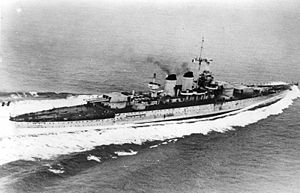 Littorio
| |
| History | |
|---|---|
| Name | Littorio |
| Namesake | The Lictor, a symbol of Italian Fascism[1] |
| Operator | Regia Marina |
| Ordered | 10 June 1934 |
| Builder | Ansaldo, Genoa Sestri Ponente |
| Laid down | 28 October 1934 |
| Launched | 22 August 1937 |
| Sponsored by | Signora Teresa Ballerino Cabella |
| Commissioned | 6 May 1940 |
| Decommissioned | 1 June 1948 |
| Renamed | Italia |
| Stricken | 1 June 1948 |
| Fate | Scrapped at La Spezia 1952–54 |
| General characteristics | |
| Class and type | Littorio-class battleship |
| Displacement | |
| Length | 237.76 m (780 ft 1 in) |
| Beam | 32.82 m (107 ft 8 in) |
| Draft | 9.6 m (31 ft 6 in) |
| Installed power |
|
| Propulsion |
|
| Speed | 30 kn (35 mph; 56 km/h) |
| Range | 3,920 mi (6,310 km; 3,410 nmi) at 20 kn (37 km/h; 23 mph) |
| Complement | 1,830 to 1,950 |
| Sensors and processing systems | EC 3 ter 'Gufo' radar |
| Armament |
|
| Armor |
|
| Aircraft carried | 3 aircraft (IMAM Ro.43 or Reggiane Re.2000) |
| Aviation facilities | 1 stern catapult |
Littorio was the lead ship of her class of battleship; she served in the Italian Regia Marina (Royal Navy) during World War II. She was named after the Lictor ("Littorio" in Italian), in ancient times the bearer of the Roman fasces, which was adopted as the symbol of Italian Fascism. Littorio and her sister Vittorio Veneto were built in response to the French battleships Dunkerque and Strasbourg. They were Italy's first modern battleships, and the first 35,000-ton capital ships of any nation to be laid down under the terms of the Washington Naval Treaty. Littorio was laid down in October 1934, launched in August 1937, and completed in May 1940.
Shortly after her commissioning, Littorio was badly damaged during the British air raid on Taranto on 11 November 1940, which put her out of action until the following March. Littorio thereafter took part in several sorties to catch the British Mediterranean Fleet, most of which failed to result in any action, the notable exception being the Second Battle of Sirte in March 1942, where she damaged several British warships. Littorio was renamed Italia in July 1943 after the fall of the Fascist government. On 9 September 1943, the Italian fleet was attacked by German bombers while it was on its way to internment. During this action, which saw the destruction of her sister Roma, Italia herself was hit by a Fritz X radio-controlled bomb, causing significant damage to her bow. As part of the armistice agreement, Italia was interned at Malta, Alexandria, and finally in the Great Bitter Lake in the Suez Canal, where she remained until 1947. Italia was awarded to the United States as a war prize and scrapped at La Spezia in 1952–54.
- ^ Whitley, p. 171